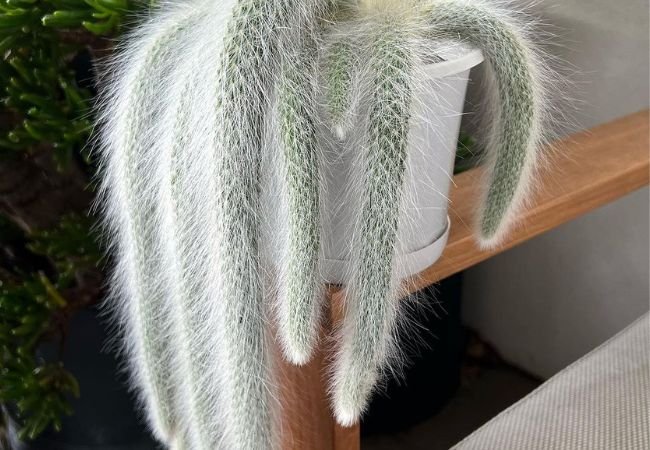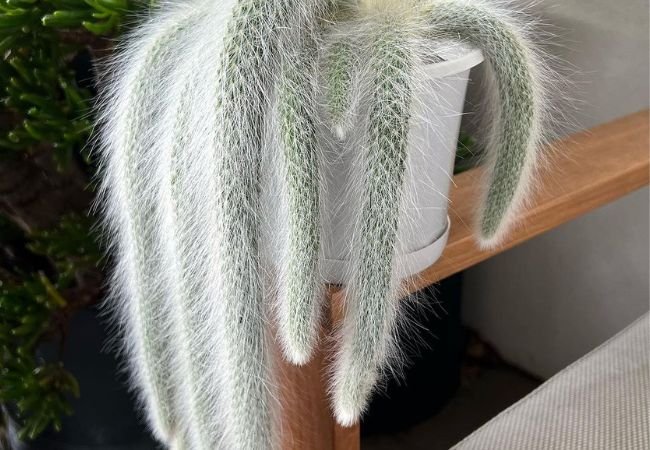Discover the Monkey’s Tail Cactus, a unique and easy-to-grow houseplant. Learn how to care for this furry cactus, solve common problems and enjoy its interesting features in your home or office.
Hey there, plant lovers! Ever seen a cactus that looks like it belongs in a Dr. Seuss book? Well, let me introduce you to the Monkey’s Tail Cactus. Trust me, it’s as fun as it sounds.
Here’s a clear and verified chart for Monkey’s Tail Cactus (Cleistocactus strausii):
| Category | Details |
|---|---|
| Botanical Name | Cleistocactus strausii |
| Common Name | Monkey’s Tail Cactus, Silver Torch Cactus |
| Plant Type | Cactus (Succulent) |
| Zone | USDA Hardiness Zones 9-11 |
| Sun Exposure | Bright, indirect light to full sun |
| Soil Type | Well-draining soil; cactus or succulent mix |
| Watering | Allow soil to dry out completely between waterings |
| Growth Habit | Columnar, trailing |
| Height/Spread | Typically 2-3 feet (60-90 cm) tall; spread up to 1-2 feet (30-60 cm) |
| Special Features | Long, spiny, silver-white stems resembling a monkey’s tail; can produce bright red flowers in summer |
What in the World is a Monkey’s Tail Cactus?

long, skinny stems covered in soft white fuzz, hanging down like, well, a monkey’s tail. That’s our guy, the Monkey’s Tail Cactus. It’s originally from Bolivia, where it hangs out on cliffs and rocks. Pretty neat, huh? If you’re curious about plant biodiversity in Bolivia, the U.S. Forest Service has some interesting info.
Why People Are Going Bananas for This Plant
- It’s a real head-turner. Seriously, your friends will do a double-take.
- It’s not fussy. Even if you don’t have a green thumb, you can keep this little dude alive.
- It’s perfect for small spaces. Apartment dwellers, rejoice!
- It’s a great conversation starter. “Hey, wanna see my monkey’s tail?” (Just kidding, don’t actually say that.)
Growing Your Own Monkey Business
Okay, so you want one. Here’s the lowdown on keeping it happy:
Light: Bright but not scorching. Think “beach with a nice umbrella” kind of light.
Water: Don’t drown it! Let the soil dry out between waterings. In winter, cut back even more.
Soil: Go for the cactus mix. Your local garden store should have it.
Temperature: Keep it cozy. Anywhere between 60°F and 80°F is golden.
Pot: Make sure it has holes. Nobody likes wet feet, especially not cacti.
Want more tips on growing cacti and succulents? The University of Florida has got your back.
Troubleshooting: When Things Go South
Even the easiest plants can give you grief sometimes. Here’s what to watch for:
- Yellow stems? Ease up on the water or move it to a brighter spot.
- Not growing? It might need more light or a little plant food.
- Tiny bugs? Those are probably mealybugs. Dab ’em with some rubbing alcohol.
For more info on identifying and managing plant pests, check out the USDA’s Animal and Plant Health Inspection Service.
Fun Facts to Impress Your Friends
- These guys are daredevils in the wild, growing on steep cliffs.
- Sometimes they’ll surprise you with cute little red or pink flowers.
- Some folks call it the “Red Hanging Monkey’s Tail.” Creative, right?
Curious about cacti and their unique adaptations? The National Park Service has some cool info.
Where to Snag Your Own Monkey’s Tail
Ready to adopt? Check out:
- Your local plant shop
- Online plant stores (just make sure they’re legit)
- Plant swap meetups in your area
Pro tip: Buy from someone you trust. You don’t want to bring home a sad, sickly plant. If you’re into plant conservation, the U.S. Fish and Wildlife Service has some interesting resources on protecting rare species.
Wrapping It Up
So there you have it, folks. The Monkey’s Tail Cactus: weird, wonderful and surprisingly easy to keep alive. Give it a shot and who knows? You might just become a cactus convert. Happy planting and may your thumbs be ever green!
For more gardening tips and plant care guides, visit usagardenhub.com.


2 thoughts on “Monkeys Tail Cactus : A Unique and Easy-to-Grow Houseplant”